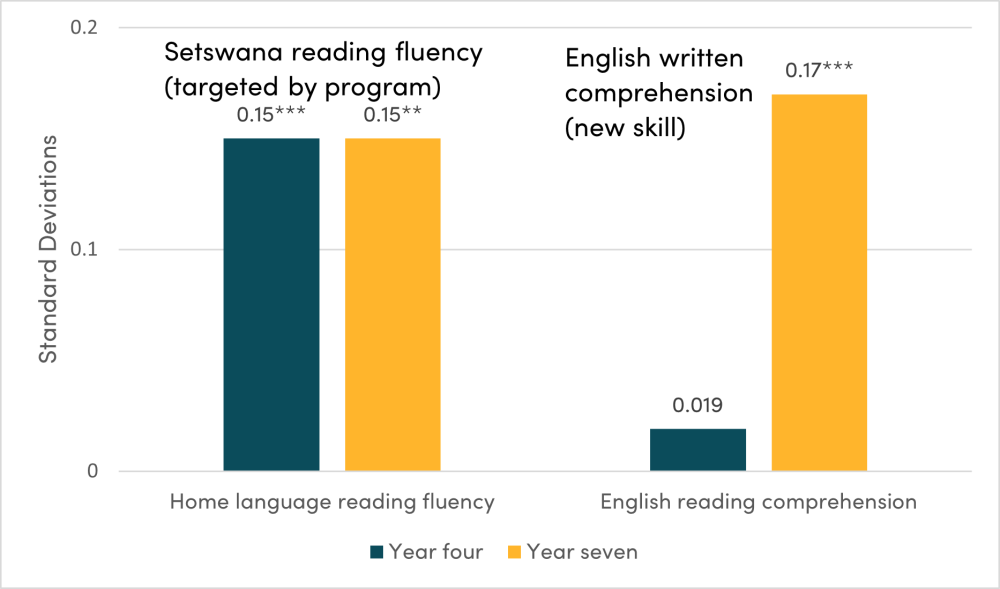Recommended
Foundational literacy skills have gained significant interest from the international community and developing country governments in recent years. For example, Sustainable Development Goal 4.4 aims to achieve universal literacy and numeracy, and the World Bank now regularly tracks “learning poverty”—the number of children who cannot read with comprehension by age 10. Additionally, several large initiatives sponsored by donor agencies prioritize foundational literacy and numeracy (FLN) skills—and FLN prioritization was a consistent theme among donors and implementers during the 2022 United Nations Transforming Education Summit. This enhanced focus on FLN stems from that fact that reading is considered an essential building block for learning that could lead to the development of other skills over time.
However, there is limited causal evidence on the long-run impacts of programs that improve foundational literacy, especially in developing countries. This is a concern, because it is possible that the initial positive impacts on FLN do not persist or that they fade considerably over time. Even if there is no fadeout, it is possible that new skills might not emerge, if the original gains were too small, or if students’ home and school environments inhibit future academic progress. In short, what if the enthusiasm around the impacts of FLN is unfounded?
Our study addresses this gap, examining the long-term effects of an early grade structured pedagogy program in South Africa, conducted from 2015 to 2017. The Early Grade Reading Study is a government led initiative that targeted the teaching of home language (Setswana) literacy and provided teachers with structured lesson plans, additional learning aids, and one-on-one coaching. Previous research documented positive impacts on student literacy after the first two years of the program. We continued tracking these students (using an experimental, longitudinal design), assessing them in their fourth and seventh years of school—one and four years after the end of their participation in the program. This allows us to test for persistence in the initial impacts, the emergence of new skills, and school progress over time.
What we found
We document the following main results:
1. There were sustained Improvements in Setswana literacy. The observed improvements in Setswana oral reading fluency and written comprehension remained roughly the same, both one and four years after the end of the program (Figure 1).
2. New skills emerged. Treated students showed significant improvement in English written comprehension. This was a new development not seen in previous years, for a skill that was not taught in the EGRS I program (Figure 1).
3. Improvements were not equal. While all treated students improved their reading fluency, the top-performing students showed the most significant gains in English and Setswana comprehension skills.
4. Grade progression improved. Treated students were found to be roughly 9 percentage points (or 15 percent) more likely to reach grade 7 by their seventh year of school (thus not repeating a grade).
Figure 1. Effect sizes for persistence and emergence of new skills, by year

Notes. Each bar indicates the magnitude of the treatment effect in terms of standard deviations. The left two bars show the impact on Setswana oral language proficiency. The right two bars show the impact on English written comprehension. The color of the bars denotes the year of data collection: which children were in their fourth (teal) and seventh (yellow) year of schooling.
Conclusion
This study provides a unique and valuable contribution to understanding the long-term effects of early literacy interventions. Our findings provide evidence that the benefits of such programs can have a lasting impact on students’ literacy and educational progression. Moreover, given that the transition to English instruction in the South African curriculum begins in grade 4, it is likely that the improved English comprehension skills measured by this study will translate to overall improved academic performance across a range of subjects. Additionally, children who progress faster through school (such as those benefitting from EGRS) are more likely to complete secondary education, thus providing them with more opportunities for continued study and better job prospects. These are only conjectures, and we plan to continue tracking these students to measure longer-term impacts.
The study highlights two critical rationales for investing in foundational literacy. First, skills beget skills: improved literacy in one language can enhance comprehension in another. Second, students with basic literacy skills are more likely to progress in their schooling, reducing dropout rates.
However, the uneven advancement across different student performance levels indicates that there may be thresholds in the development of new skills. This suggests a need for additional support for lower-performing students to fully realize the benefits of such interventions.
While additional evidence on the long-term impacts of foundational literacy programs is needed, our study supports the growing focus on early intervention and investment in literacy as a policy decision in low- and middle-income countries.
Disclaimer
CGD blog posts reflect the views of the authors, drawing on prior research and experience in their areas of expertise. CGD is a nonpartisan, independent organization and does not take institutional positions.
Image credit for social media/web: Kehitys Lehti Flickr CC BY-NC 2.0 DEED








